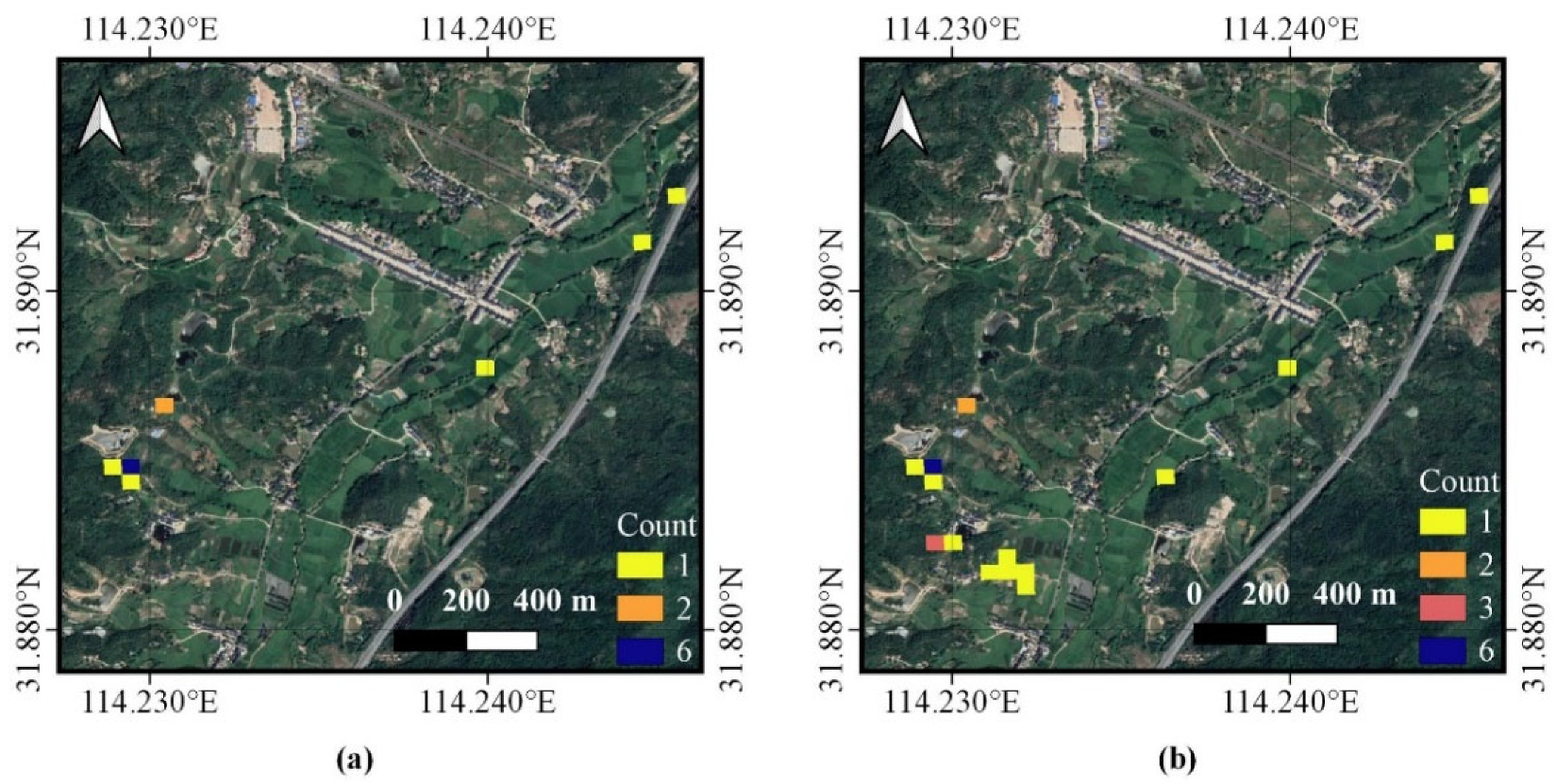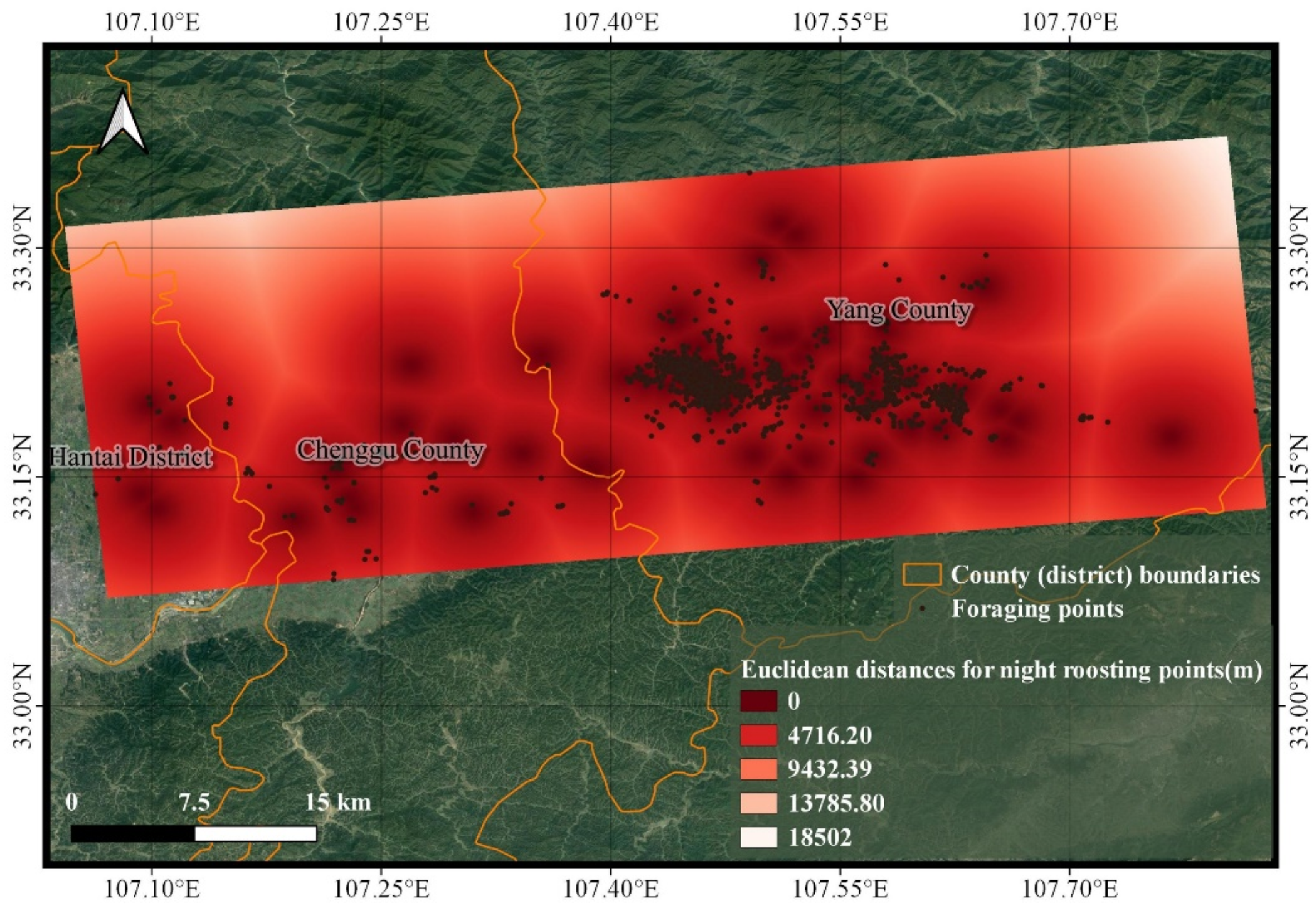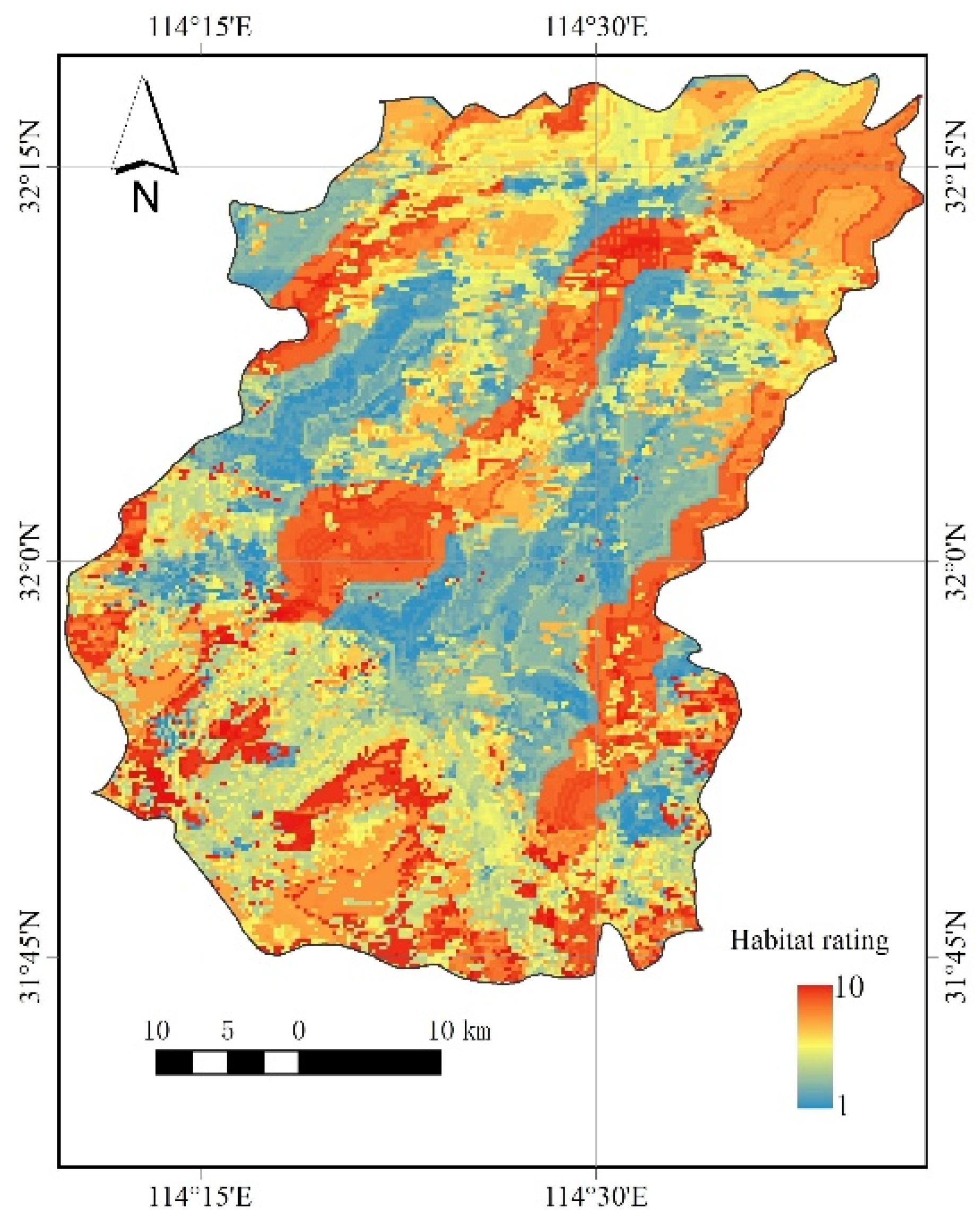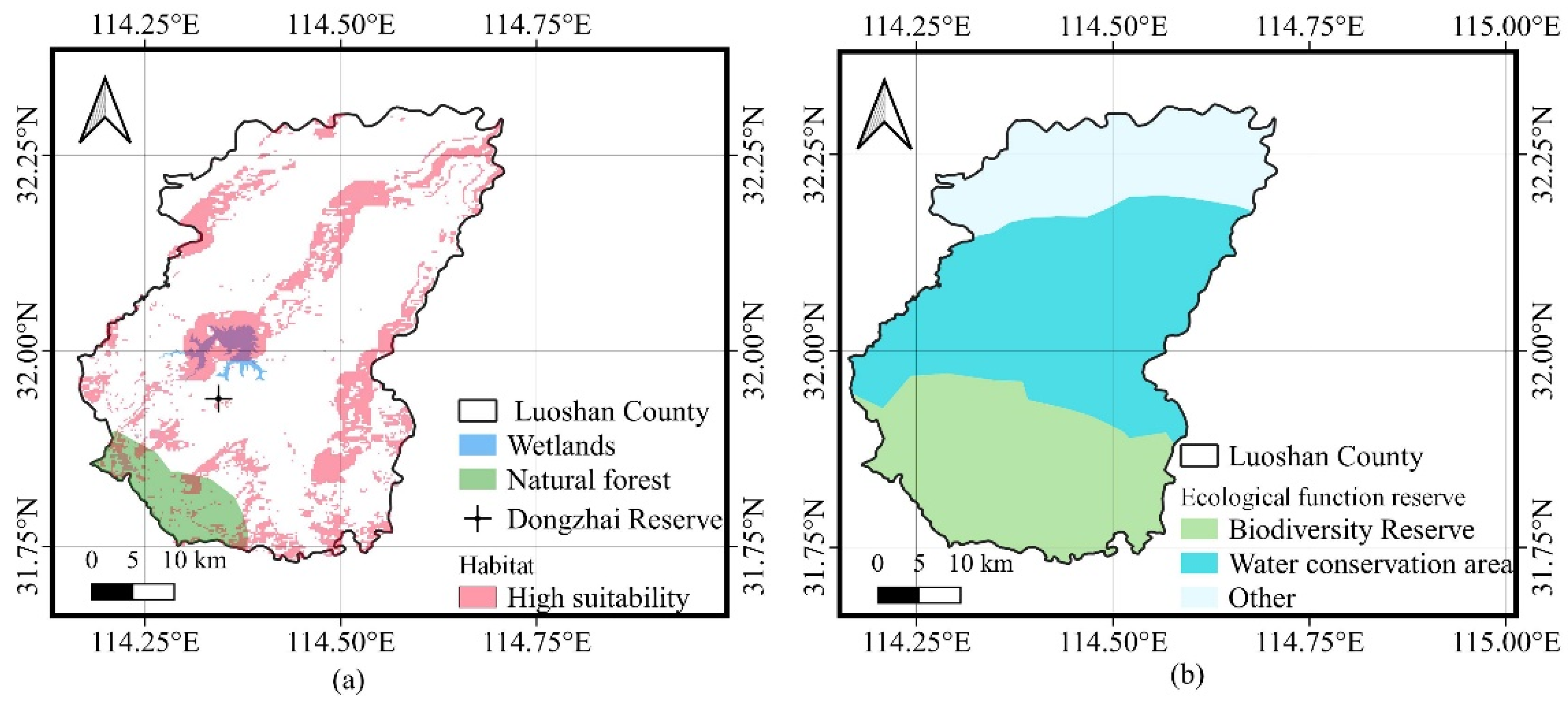Spatial- and Temporal-Trajectory Analysis of the Crested Ibis (Nipponia nippon) by Fusing Multiple Sources of Data
Abstract
Simple Summary
Abstract
1. Introduction
2. Materials and Methods
2.1. Study Area and Data
2.2. Trajectory Data Supplement
2.3. Night-Roosting-Points Identification and Analysis
2.4. Habitat Prediction Based on Random Forest
3. Results
3.1. Trajectory-Data Supplementation
3.2. Spatial Patterns of Trajectory Points
3.3. Potential Habitat Mining
4. Discussion
5. Conclusions
Supplementary Materials
Author Contributions
Funding
Informed Consent Statement
Data Availability Statement
Acknowledgments
Conflicts of Interest
References
- Mace, G.M.; Collar, N.; Cooke, J.; Gaston, K.; Ginsberg, J.; Leader-Williams, N.; Maunder, M.; Milner-Gulland, E. The Development of New Criteria for Listing Species on the IUCN Red List. Verlag Nicht Ermittelbar. 1992. Available online: https://www.researchgate.net/profile/Georgina-Mace/publication/236679197_The_development_of_new_criteria_for_listing_species_on_the_IUCN_Red_List/links/0046352cece3a00c66000000/The-development-of-new-criteria-for-listing-species-on-the-IUCN-Red-List.pdf (accessed on 6 December 2022).
- Fahrig, L. How much habitat is enough? Biol. Conserv. 2001, 100, 65–74. [Google Scholar] [CrossRef]
- Li, X.H.; Li, D.M.; Ding, C.Q.; Cao, Y.H.; Lu, X.R.; Fu, W.K.; Ma, Z.J.; Lu, B.Z.; Zhai, J. A preliminary evaluation of the habitat quality of the Crested ibis (Nipponia nippon). Biodiv. Sci. 1999, 7, 161. [Google Scholar]
- IUCN. The IUCN Red List of Threatened Species. Version 2019-3. IUCN Global Species Programme Red List Unit United Kingdom. 2019. Available online: https://www.iucnredlist.org/ (accessed on 10 December 2019).
- Li., J.; Zhu, X. The value of Crested Ibis and its status and role in natural museums. In Proceedings of the International Crested Ibis Conservation Symposium, Shaanxi, China, 6 September 1999. [Google Scholar]
- Li, X.; Tian, H.; Li, D.J.B. Why the crested ibis declined in the middle twentieth century. Biodivers. Conserv. 2009, 18, 2165–2172. [Google Scholar] [CrossRef]
- Ma, L.; Li, X.; Zhai, T.; Zhang, Y.; Song, K.; Holyoak, M.; Sun, Y.J.A. Changes in the Habitat Preference of Crested Ibis (Nipponia nippon) during a Period of Rapid Population Increase. Animals 2021, 11, 2626. [Google Scholar] [CrossRef]
- Zhang, Y.; Wang, F.; Cui, Z.; Li, M.; Li, X.; Ye, X.; Yu, X. Can we reestablish a self-sustaining population? A case study on reintroduced Crested Ibis with population viability analysis. Avian Res. 2021, 12, 1–10. [Google Scholar] [CrossRef]
- Sun, Y.; Skidmore, A.K.; Wang, T.; van Gils, H.A.; Wang, Q.; Qing, B.; Ding, C. Reduced dependence of Crested Ibis on winter-flooded rice fields: Implications for their conservation. PLoS ONE 2014, 9, e98690. [Google Scholar] [CrossRef] [PubMed]
- Wang, Q.; Zhang, J.; Yan, W.B.; Wu, J. Spatial-temporal characteristics of vegetation cover in typical habitat of Crested Ibis. Ecol. Sci. 2019, 38, 193. [Google Scholar]
- Yu, F.; Sun, Y.; Wang, T.; Skidmore, A.K.; Ding, C.; Ye, X. Linking the past and present to predict the distribution of Asian crested ibis (Nipponia nippon) under global changes. Integr. Zool. 2022, 17, 1095–1105. [Google Scholar] [CrossRef]
- Xinhai, L.; Zhijun, M.; Changqing, D.; Tianqing, Z.; Dianmo, L. Relationship between the distribution of Crested Ibis and local farmers. Acta Zool. Sin 2002, 48, 725–732. [Google Scholar]
- Dong, R.; Ye, X.; Zhong, L.; Li, X.; Li, M.; Wang, H.; Yu, X. Effects of breeding success, age and sex on breeding dispersal of a reintroduced population of the Crested Ibis (Nipponia nippon) in Ningshan County, China. Avian Res. 2018, 9, 1–7. [Google Scholar] [CrossRef]
- Endo, C.; Nagata, H. Seasonal changes of foraging habitats and prey species in the Japanese Crested Ibis Nipponia nippon reintroduced on Sado Island, Japan. Bird Conserv. Int. 2013, 23, 445–453. [Google Scholar] [CrossRef]
- Li, L.; Hu, R.; Huang, J.; Bürgi, M.; Zhu, Z.; Zhong, J.; Lü, Z. A farmland biodiversity strategy is needed for China. Ecol. Evol. 2020, 4, 772–774. [Google Scholar] [CrossRef] [PubMed]
- Li, X.; Fu, J.; Zhai, T.; Zhang, Y.; Bruford, M.W.; Sun, Y.; Zhan, X. Understanding recovery is as important as understanding decline: The case of the crested ibis in China. Land 2022, 11, 1817. [Google Scholar] [CrossRef]
- Huo, Z.; Guo, J.; Li, X.; Yu, X. Post-fledging dispersal and habitat use of a reintroduced population of the Crested Ibis (Nipponia nippon). Avian Res. 2014, 5, 1–9. [Google Scholar] [CrossRef]
- Huang, Y.; Ye, Y.; Zhang, Y.; Barras, A.G.; Wang, C.; Qing, B.; Ding, C. Tall trees drive the nest-site selection of wild Crested Ibis Nipponia nippon. Bird Conserv. Int. 2022, 32, 1–12. [Google Scholar] [CrossRef]
- Rew, J.; Park, S.; Cho, Y.; Jung, S.; Hwang, E. Animal movement prediction based on predictive recurrent neural network. Sensors 2019, 19, 4411. [Google Scholar] [CrossRef] [PubMed]
- Ji, G.L.; Zhao, J. Research Progress in Pattern Mining for Big Spatio-temporal Trajectories. J. Data Acquis. Process. 2015, 30, 47–58. [Google Scholar]
- Jiang, X.; Yang, T.; Liu, D.; Zheng, Y.; Chen, Y.; Li, F. An Automatic Identification Method of Crested Ibis (Nipponia nippon) Habitat Based on Spatiotemporal Density Detection. Animals 2022, 12, 2220. [Google Scholar] [CrossRef] [PubMed]
- Zheng, L.; Wang, Y.; Zhu, J.; Wang, K.; Cai, D.; Qin, Y.; Guo, Y.; Niu, H.; Bu, Y. Habitat evaluation for reintroduced crested Ibis (Nipponia nippon) in Dongzhai national nature reserve, China, based on a maximum entropy model. Pak. J. Zool. 2018, 50, 1319–1327. [Google Scholar] [CrossRef]
- Sun, Y.; Wang, T.; Skidmore, A.K.; Palmer, S.C.; Ye, X.; Ding, C.; Wang, Q. Predicting and understanding spatio-temporal dynamics of species recovery: Implications for Asian crested ibis Nipponia nippon conservation in China. Divers. Distrib. 2016, 22, 893–904. [Google Scholar] [CrossRef]
- Zhou, X.H.; Jiang, L.; Wang, Q.; Zhang, W.; Cheng, K.; Ding, J. The tolerance of human disturbance on Crested Ibis (Nipponia nippon) of wardering stage. Acta Ecol. Sin. 2009, 29, 5176–5184. [Google Scholar]
- Lu, S.H.; Huang, Z.X.; Yuan, G.J.; Cai, D.J.; Zhao, H.; Mei, X.X.; Wang, J.; Zhu, J. Influencing factors the reproduction of wild of Nipponia nippon in Dongzhai nature reserve, Henan Province. Ecol. Sci. 2021, 40, 184. [Google Scholar]
- Hu, H.; Tang, J.; Wang, Y.; Zhang, H.; Lin, Y.; Su, L.; Liu, Y.; Zhang, W.; Wang, C.; Wu, D. Evaluating bird collision risk of a high-speed railway for the crested ibis. Transp. Res. Part D Transp. Environ. 2020, 87, 102533. [Google Scholar] [CrossRef]
- Li, M.; Tuohetahong, Y.; Lin, F.; Dong, R.; Wang, H.; Wu, X.; Ye, X.; Yu, X. Factors affecting post-release survival and dispersal of reintroduced Crested Ibis (Nipponia nippon) in Tongchuan City, China. Avian Res. 2022, 13, 100054. [Google Scholar] [CrossRef]
- Liu, D.; Zhang, G.; Wang, C.; Qing, B.; Lu, J. Breeding variation in a reintroduced crested ibis nipponia nippon population in Central China. Pak. J. Zool. 2020, 52, 1595–1598. [Google Scholar] [CrossRef]
- Okahisa, Y.; Nagata, H. Evaluation of ongoing Crested Ibis (Nipponia nippon) reintroduction using an integrated population model and Bayesian population viability analysis. IBIS 2022, 164, 1104–1122. [Google Scholar] [CrossRef]
- Phillips, S.J.; Dudík, M. Modeling of species distributions with Maxent: New extensions and a comprehensive evaluation. Ecography 2008, 31, 161–175. [Google Scholar] [CrossRef]
- Zhu, G.; Qiao, H. Effect of the Maxent model’s complexity on the prediction of species potential distributions. Biodivers. Sci. 2016, 24, 1189. [Google Scholar] [CrossRef]
- Geospatial Data Cloud. Available online: https://www.gscloud.cn/search (accessed on 26 December 2022).
- GlobeLand30. Available online: http://www.globeland30.org/defaults_en.html?src=/Scripts/map/defaults/En/download_en.html&head=download&type=data (accessed on 26 December 2022).
- National Catalogue Service for Geographic Information. Available online: https://www.webmap.cn/commres.do?method=result25W (accessed on 26 December 2022).
- OpenStreetMap Database. Available online: https://www.openstreetmap.org/export#map=12/32.1715/114.6279 (accessed on 26 December 2022).
- Robusto, C.C. The cosine-haversine formula. Am. Math. Mon. 1957, 64, 38–40. [Google Scholar] [CrossRef]
- Wang, K.F.; Shi, D.C. Observation of Anniversary and Daily Activity of the Created Ibis. In Proceedings of the International Crested Ibis Conservation Symposium, Shaanxi, China, 6 September 1999. [Google Scholar]
- Ester, M.; Kriegel, H.-P.; Sander, J.; Xu, X. A Density-Based Algorithm for Discovering Clusters in Large Spatial Databases with Noise. In Proceedings of the KDD’96: Proceedings of the Second International Conference on Knowledge Discovery and Data Mining, Portland, OR, USA, 2–4 August 1996; AAAI Press: Palo Alto, CA, USA, 1996; pp. 226–231. [Google Scholar]
- Zaki, M.J.; Meira, W., Jr. Data Mining and Machine Learning: Fundamental Concepts and Algorithms; Cambridge University Press: Cambridge, UK, 2020; pp. 375–380. [Google Scholar]
- Har-Peled, S.; Sadri, B. How fast is the k-means method? Algorithmica 2005, 41, 185–202. [Google Scholar] [CrossRef]
- Rousseeuw, P.J. Silhouettes: A graphical aid to the interpretation and validation of cluster analysis. JCAM 1987, 20, 53–65. [Google Scholar] [CrossRef]
- Breiman, L. Random forests. Mach Learn 2001, 45, 5–32. [Google Scholar] [CrossRef]
- Wang, C.; Liu, D.; Qing, B.; Ding, H.; Cui, Y.; Ye, Y.; Lu, J.; Yan, L.; Ke, L.; Ding, C. The current population and distribution of wild Crested Ibis Nipponia nippon. Chin. J. Zool. 2014, 49, 666–671. [Google Scholar]
- Tao, A.M.Y.W.S.; Lü, Y.K.H.W.Z. Research status and challenges of road impacts on wildlife in China. Biodivers. Sci. 2022, 22209. [Google Scholar]
- Ardakani, I.; Hashimoto, K.; Yoda, K. Context-based semantical vector representations for animal trajectories. Adv. Robot. 2019, 33, 118–133. [Google Scholar] [CrossRef]
- Hirakawa, T.; Yamashita, T.; Tamaki, T.; Fujiyoshi, H.; Umezu, Y.; Takeuchi, I.; Matsumoto, S.; Yoda, K. Can AI predict animal movements? Filling gaps in animal trajectories using inverse reinforcement learning. Ecosphere 2018, 9, e02447. [Google Scholar] [CrossRef]
- Wijeyakulasuriya, D.A.; Eisenhauer, E.W.; Shaby, B.A.; Hanks, E.M. Machine learning for modeling animal movement. PLoS ONE 2020, 15, e0235750. [Google Scholar] [CrossRef]
- Gers, F.A.; Schmidhuber, J.; Cummins, F. Learning to forget: Continual prediction with LSTM. Neural Comput. 2000, 12, 2451–2471. [Google Scholar] [CrossRef]









| ID | Date | Location | Numbers of Trajectory |
|---|---|---|---|
| 4B04A0 | 16 July 2014–30 December 2021 | Luoshan County, Henan Province | 6541 |
| 4B03DB | 16 July 2014–30 December 2021 | Luoshan County, Henan Province | 1878 |
| CAFL004 | 24 July 2015–30 December 2021 | Hantai District, Chenggu County, Yang County in Shaanxi Province | 18,600 |
| 8013 | 24 July 2015–30 December 2021 | Yang County in Shaanxi Province | 220 |
| 8014 | 24 July 2015–30 December 2021 | Yang County in Shaanxi Province | 2769 |
| 8022 | 24 July 2015–30 December 2021 | Chenggu County, Yang County in Shaanxi Province | 947 |
| 8026 | 24 July 2015–30 December 2021 | Chenggu County, Yang County in Shaanxi Province | 870 |
| Name | Sources | Resolution(m) |
|---|---|---|
| Google Maps | Satellite LANDSAT-8, QuickBird, etc. | 0.5 m |
| DEM (digital elevation model) [32] | Geospatial Data Cloud | 30 m |
| GlobeLand30 land cover data [33] | GlobeLand30 | 30 m |
| NDVI (normalized difference vegetation index) [32] | Geospatial Data Cloud | 250 m |
| River vector data [34] | National Catalogue Service for Geographic Information | / |
| Road vector data [35] | OpenStreetMap database | / |
| Location Points | March–October | November–February |
|---|---|---|
| Night roost points | 21:00–5:00 | 20:00–6:00 |
| Foraging points | 8:00–16:00 | 9:00–16:00 |
| Outing points | 5:00–8:00 16:00–21:00 | 6:00–7:00 16:00–20:00 |
| Precision Evaluation Indicators | R2 | RMSE | MAE | Explained_Variance |
|---|---|---|---|---|
| Value | 84.9% | 21.0 | 12.6 | 85.7% |
Disclaimer/Publisher’s Note: The statements, opinions and data contained in all publications are solely those of the individual author(s) and contributor(s) and not of MDPI and/or the editor(s). MDPI and/or the editor(s) disclaim responsibility for any injury to people or property resulting from any ideas, methods, instructions or products referred to in the content. |
© 2023 by the authors. Licensee MDPI, Basel, Switzerland. This article is an open access article distributed under the terms and conditions of the Creative Commons Attribution (CC BY) license (https://creativecommons.org/licenses/by/4.0/).
Share and Cite
Zhou, Y.; Jiang, X.; Chen, Z. Spatial- and Temporal-Trajectory Analysis of the Crested Ibis (Nipponia nippon) by Fusing Multiple Sources of Data. Animals 2023, 13, 237. https://doi.org/10.3390/ani13020237
Zhou Y, Jiang X, Chen Z. Spatial- and Temporal-Trajectory Analysis of the Crested Ibis (Nipponia nippon) by Fusing Multiple Sources of Data. Animals. 2023; 13(2):237. https://doi.org/10.3390/ani13020237
Chicago/Turabian StyleZhou, Yulong, Xian Jiang, and Zhanlong Chen. 2023. "Spatial- and Temporal-Trajectory Analysis of the Crested Ibis (Nipponia nippon) by Fusing Multiple Sources of Data" Animals 13, no. 2: 237. https://doi.org/10.3390/ani13020237
APA StyleZhou, Y., Jiang, X., & Chen, Z. (2023). Spatial- and Temporal-Trajectory Analysis of the Crested Ibis (Nipponia nippon) by Fusing Multiple Sources of Data. Animals, 13(2), 237. https://doi.org/10.3390/ani13020237






